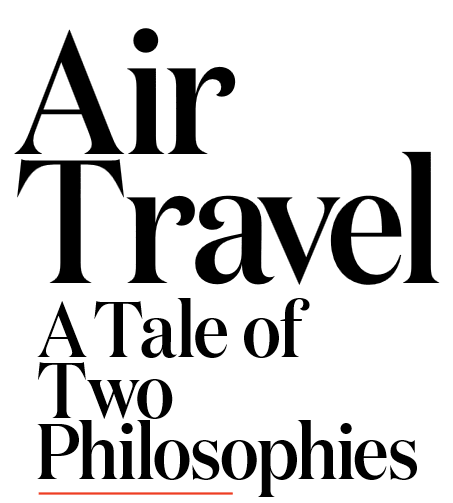Low-cost carriers (LCCs) are thriving both within the United States and internationally. Look no further than Southwest Airlines in the USA and easyJet in Europe. There are more examples—Spirit Airlines, Allegiant Air, Ryanair, JetBlue, AirAsia, and the list goes on. Customers on these airlines are the “value” sector. Value customers know that they are getting no frills, à la carte pricing, usually twenty-nine-inch seat pitch, crowded gates, and most important, low fares—or at least the perception of low fares.
On the other end, those who can afford it are finding more and more ways to avoid the airlines—particularly domestically in the United States. The private jet charter business has never been as active as it is today. New “travel member clubs” such as Wheels Up, Surf Air, Rise, and others are popping up, selling tickets and raising lots of capital. These carriers provide a “value added” service to include concierge services, private terminals, direct flights between small airports, new aircraft with excellent amenities, and most important, customer service that is respectful, genuine, and targeted toward the business and premium-seat traveler.
“We are seeing the beginning of a significant change in the way that customers select their air carrier.” Scott Terry, CEO, TEMPUS Inc.
Large, established air carriers in the USA are consolidating, reducing domestic routes, and putting more emphasis on international operations while some European carriers such as Air France–KLM are facing significant financial problems and identity crises as never before. The pressure on the traditional mainline carriers is coming from all fronts. The LCCs are doing their damage, but an even larger threat is coming from the Middle Eastern and Asian flag carriers whose commitment to impeccable customer service, new equipment, and expanding route structures is stealing business and premium-seat travelers by the thousands.
The result is confusion and hesitation with the mainline carriers. I’m sure that Richard Anderson, the CEO of Delta Air Lines, a man who seems to speak his mind quite freely, would say that his company has a solid strategy to maximize shareholder value in today’s competitive environment. However, if Delta’s best strategy is to lobby the U.S. government to pull every legislative trick in the book to restrict new entrants in the U.S. market (for example, Norwegian long-haul LCC) and premium-service providers (such as Emirates and Etihad), perhaps Anderson should look in the mirror first. No U.S. carrier, with the possible exception of Virgin America, can remotely compare their customer service and in-flight amenities to those of the Singapore Airlines and Cathay Pacifics of the world.
Another interesting move by U.S. mainline carriers is the continuous reduction in services in the Lower 48. So many communities have been cut from the route structures of the consolidating carriers that the U.S. government’s Essential Air Service subsidy program is a growth industry within the American aviation market. Smaller carriers are finding ample opportunities for profitable operations by taking federal subsidies to ensure that as many Americans as possible have access to commercial air service.
The U.S. flag carriers cannot survive long term by continuing to attempt to be all things to all people. It is clear that by dropping thin domestic routes with in their hub and spoke system and adding international service, the big three (Delta, American, United) are betting on lucrative long-haul routes and have given up on the “value” traveler. But unless the big three attack the service element that travel member clubs and foreign major carriers have perfected, this big bet may result in U.S. flag carriers that will become as irrelevant as Air
France–KLM is now.
In an industry that thrives on the status quo, the success of alternative methods of air travel, whether it’s a sixty-nine-dollar fare on Spirit, a private three-room suite on the upper deck of an Airbus A380 from Etihad, or a trip on a private King Air 350 from Dallas to Midland and back on your schedule, is a clear and present danger to the air carrier establishment. As time marches on, it appears that carriers must select an air traveler philosophy to which they should attach themselves. Sort of like American politics in this day and age, I guess—it’s red or blue and not a whole lot in the middle. Whatever the decision, the price of a gallon of jet fuel seems to be the least of the worries, or excitement, for U.S. mainline air carriers.


